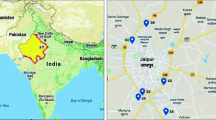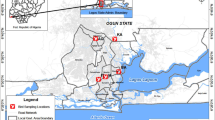Abstract
Considering one health concept, human health is thought to be affected by many factors. Heavy metal toxicity is now gaining its place as one of the major factors contributing to detrimental outcomes for human health. The study encompassed to target sites close to the industrial area of Lahore where heavy metal levels are believed to be higher, as industrial waste is drained into the two main drains. Sheep and goats (n = 5 from each species) reared in the locality were included in the study, and effects of heavy metal toxicity were evaluated in the selected organs (intestine, kidneys, liver, and muscles) via histopathological examination along with residual concentration of these heavy metals in the aforementioned organs. Heavy metals chromium, copper, zinc, lead, iron, magnesium, manganese, and nickel were detected in sample of selected organs by atomic absorption spectrometry (AAS) along with digestion method. The findings of the study indicated a statistically significant difference of residual concentrations of almost all the selected elements in almost all the tissue samples between the two sites where the values of site 1 (close to the drain) were higher compared with site 2 (away from the drain). Similar trend was depicted in histopathological examination where a higher degree of tissue degeneration, necrosis, and hence organ damage was observed in tissue samples collected from site 1 compared with site 2.









Similar content being viewed by others
References
Abalaka SE (2015) Heavy metals bioaccumulation and histopathological changes in Auchenoglanis occidentalis fish from Tiga dam, Nigeria. J Environ Health Sci Eng 13(1):67
Bala A, Suleiman N, Junaidu AU, Salihu MD, Ifende VI, Saulawa MA, Magaji AA, Faleke OO, Anzaku SA (2014) Detection of lead (Pb), cadmium (Cd), chromium (Cr) nickel (Ni) and magnesium residue in kidney and liver of slaughtered cattle in Sokoto central abattoir, Sokoto state, Nigeria. International Journal of Livestock Research 4(1):74–80
Bancroft JD, Gamble M (2007) Hematoxylin and eosin stains. Theory and practice of histological techniques, 6th edn. Churchill Livingstone, New York
Bantu N, Kumar R, Vakita V (2017) Acute toxicity and respiratory responses in freshwater fish, Labeo rohita exposed to indoxacarb. International Journal Of Sciences, Innoriginal, pp 1–5
Bhuyan G, Anandhan R, Kavitha V (2014) Qualitative and quantitative analysis of fish tissue of Oreochromis mossambicus collected from Kedilam River, Cuddalore, Tamilnadu, India. International Journal of Applied Sciences and Biotechnology 2(2):135–141
Deore SV, Wagh SB (2012) Heavy metal induced histopathological alterations in liver of Channa gachua (Ham). Journal of Experimental Sciences
Elsayed MA, Abdelrahman HA, Morshedy AEMA, (2015) Prevalence of heavy metals and trace elements in cattle edible offal. 2nd conference of Food Safety, Suez Canal University, Faculty of Vet Medicine
Food and Agricultural Organisation FAO (2002)Report of the codex committee on food additives and contaminants. Available on www.FAO/drocrep/meeting/005
Gholami MR, Ottarod V, HABL AM, EZI A (2004) Pathology of natural and experimental lead poisoning in cattle. Archives of Razi Institute 57:133–138
Jamal Q, Durani P, Khan K, Munir S, Hussain S, Munir K, Anees M (2013) Heavy metals accumulation and their toxic effects. Journal of Bio-Molecular Sciences 1(1):27–36
Kar I, Mukhopadhayay SK, Patra AK, Pradhan S (2018) Bioaccumulation of selected heavy metals and histopathological and hematobiochemical alterations in backyard chickens reared in an industrial area, India. Environ Sci Pollut Res 25(4):3905–3912
Kaur S, Khera KS, Kondal JK (2018) Heavy metal induced histopathological alterations in liver, muscle and kidney of freshwater cyprinid, Labeo rohita (Hamilton). J Entomol Zool Stud 6(2):2137–2144
Kennish MJ (1992) Ecology of estuaries. Anthropogenic effects, vol F1. CRC. Press. Inc., Boca Raton, p 494
Khalafalla FA, Abdel-Atty NS, Abd-El-Wahab MA, Ali OI, Abo-Elsoud RB (2015) Assessment of heavy metal residues in retail meat and offals. J Am Sci 11(5):50–54
Lemos RA, Driemeier D, Guimarães EB, Dutra IS, Mori AE, Barros CS (2004) Lead poisoning in cattle grazing pasture contaminated by industrial waste. Vet Hum Toxicol 46(6):326–328
Licata P, Trombetta D, Cristani M, Giofre F, Martino D, Calo M, Naccari F (2004) Levels of “toxic” and “essential” metals in samples of bovine milk from various dairy farms in Calabria, Italy. Environ Int 30(1):1–6
Mahboob S, Al-Ghanim KA, Al-Balawi HF, Al-Misned F, Ahmed Z (2020) Toxicological effects of heavy metals on histological alterations in various organs in Nile tilapia (Oreochromis niloticus) from freshwater reservoir. Journal of King Saud University-Science 32(1):970–973
Mahmoud SA, Abd El Rahman AA (2017) Eco-toxicological studies of water and their effect on fish in El Manzalah Lake. RJPBCS 8(2):2497–2511
Rahim M, Ullah I, Khan A, Haris MRHM (2016) Health risk from heavy metals via consumption of food crops in the vicinity of District Shangla. J Chem Soc Pak 38(1)
Ramirez R (2013) The gastropod Osilinus atrata as a bioindicator of Cd, Cu, Pb and Zn contamination in the coastal waters of the Canary Islands. =
Richards LA (1968) Diagnosis and improvement of saline and alkali soils.1st Ed., Agriculture handbook No. 60:210-220. IBH Publications Company New Delhi India
Sajid M, Younus M, Khan M, Anjum AA (2018) Assessing lead (Pb) residues in Lohi sheep and its impact on hematological and biochemical parameters. Pol J Environ Stud 27(4):1717–1723
Sanaa AA, Fatma FM, Eman FM (2015) Estimation of some heavy metals residues in blood serum and tissues of camels. Assiut Vet Med J 61(145):221–229
Seiyaboh EI, Kigigha LT, Aruwayor SW, Izah SC (2018) Level of selected heavy metals in liver and muscles of cow meat sold in Yenagoa Metropolis, Bayelsa State, Nigeria. Int J Pub Health Safety 3:2
Sharaf S, Khan MUR, Aslam A, Rabbani M (2020) Comparative study of heavy metals residues and histopathological alterations in large ruminants from selected areas around industrial waste drain. Pak Vet J 40(1)
Srivastava S, Goyal P (2010) Heavy metals: environmental threat. In: Novel biomaterials. Springer, Berlin, pp 1–10
Steenland K, Boffetta P (2000) Lead and cancer in humans: where are we now? Am J Ind Med 38(3):295–299
Sultana T, Butt K, Sultana S, Al-Ghanim KA, Mubashra R, Bashir N, Ahmed Z, Ashraf A, Mahboob S (2016) Histopathological changes in liver, gills and intestine of Labeo rohita inhabiting industrial waste contaminated water of river Ravi. Pakistan Journal of Zoology 48(4)
World Health Organization (2016) The public health impact of chemicals: knowns and unknowns (no. WHO/FWC/PHE/EPE/16.01). World Health Organization, Geneva, p 13
World Health Organization (2017) Lead poisoning and health [internet]. Geneva: World Health Organization [WHO]; [cited 2017 August]. Available from: http://www.who.int/mediacentre/factsheets/fs379/en/
Author information
Authors and Affiliations
Corresponding author
Additional information
Responsible Editor: Philippe Garrigues
Publisher’s note
Springer Nature remains neutral with regard to jurisdictional claims in published maps and institutional affiliations.
Rights and permissions
About this article
Cite this article
Sharaf, S., Khan, MuR., Aslam, A. et al. Toxico-pathological effects of heavy metals from industrial drainage wastewater on vital organs of small ruminants in Lahore. Environ Sci Pollut Res 28, 3533–3543 (2021). https://doi.org/10.1007/s11356-020-10051-4
Received:
Accepted:
Published:
Issue Date:
DOI: https://doi.org/10.1007/s11356-020-10051-4




